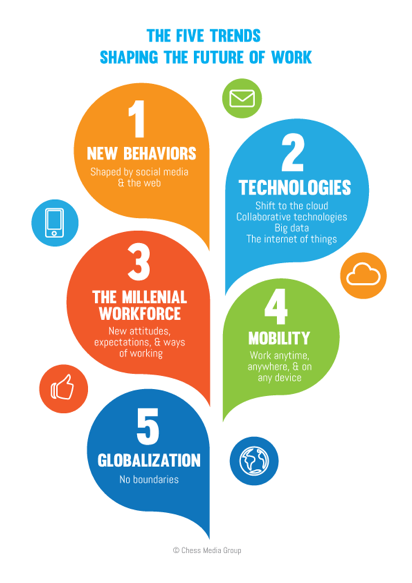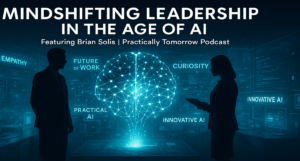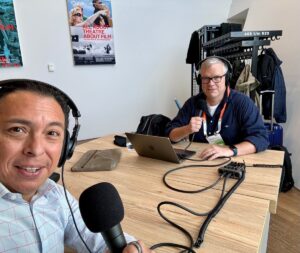Guest post by Jacob Morgan, author of the newly released, The Future of Work: Attract New Talent, Build Better Leaders, and Create a Competitive Organization. You can connect with Jacob on Twitter or email him directly: Jacob@ChessMediaGroup.com.
If there’s one thing that we can all agree on it’s that the world of work is changing…quickly. The way we have been working over the past few years is NOT how are we are going to be working in the coming years. Perhaps one of the most important underlying factors driving this change is the coming shift around who drives how work gets done. Traditionally executives would set the rules and pass those down to managers who in turn would pass those down to employees. But as Dan Pink aptly put it, “talented people need organizations less than organizations need talented people.” In other words employees are now starting to drive the decisions and conversations around how work gets done, when it gets done, who it gets done with, what technologies are being used to get it done, etc. The next few years are going to bring about dramatic changes. But why now? What are the key trends that are driving this new future of work? There are five of them as seen below.
New behaviors
Ten years ago if someone were to tell you that you would have all this information about yourself public for the world to read, see and hear, you would have said they were crazy. Now look at where we are, we are so much more comfortable living more public lives, we build communities, share, communicate, collaborate, access information, and shape our personal experiences. All these new behaviors are cascading over organizations which is forcing them to make changes.
Technologies
Big data, the cloud, the internet of things, robots, automation, video, collaboration platforms, and other technologies are changing the way we work and live. The cloud puts the power of technology in the hands of employees, robots and software are forcing us to rethink the jobs that humans can and should do, big data gives us insight into how we work and how customers transact with use, and collaboration platforms give us the ability to connect our people and information together anywhere, anytime, and on any device.
Millennials in the workplace
By 2020 millennials are expected to make up around 50% of the workforce, by 2025 this number is projected to be 75%. The important thing about millennials isn’t the fact that they might bring new approaches, ideas, values, or styles of working; it’s that there are going to be so many of them. They are by all accounts going to be the largest generation to ever enter the workforce. This is a generation of employees with technological fluency that is willing to live at home longer until they find a company that they truly want to work for. In other words, organizations must shift from creating an environment where they assume that people NEED to work there to one where people WANT to work there.
Mobility
It’s absolutely fascinating that living in the Bay Area, I can access virtually the same type of information that someone else can living in a remote rice patty field in China. Today where you are is starting to matter much less when it comes to being able to do your job. As long as you can connect to the internet, chances are you can access the same people and information as if you were working in an office building. We are connected anywhere and everywhere we go whether it be 35,000 in the air or in a home office.
Globalization
This is essentially the ability for organizations to work in a world where boundaries do not exist. The world is becoming just like one big city. The language you speak, the currency you transact in, and where you are physically located are starting to matter less and less. You can work in San Francisco yet have clients in Beijng or Melbourne; the same goes for employees. Boundaries to working with anyone and anywhere are being crushed and this trend will only continue.
So what do you do now?
First, make sure you understand what these five trends are and how they are going to impact your business. For example if you are in retail you should absolutely be thinking about things like mobility, the internet of things, robots and automation. If you are in finance you should be exploring how to attract and retain top talent and the future workforce. If you are in professional services then understanding globalization is going to be crucial. These are just a few examples but the important thing is to think through the potential implications of these trends on you and your organization.
Second, run experiments and tests constantly and frequently. In a world where the rate of change is rapidly increasing the best thing to do is act as a scientist. Your company is a lab where you need to challenge conventional ideas around how work gets done. Don’t take anything for granted.
Third, implement broad based changed based on the experiments you run. So, if you text out something like flexible work in marketing and find that the results are positive then the next step should be exploring how something like this can be rolled out to the entire company. GE is doing an excellent job of exemplifying this by rolling out their “lean startup” approach to various parts of the organization.
When it comes to the future of work “late adopter is equivalent to out of business.” The question that you should be asking yourselves is what is your organizations doing about these five trends to make sure that you can succeed in the new world of work? If your organization doesn’t think about and plan for the future of work then your organization will have no future.







Mobility is definitely a big factor, Jacob. More and more often people are working out with an office environment. The way we work has also had a knock on effect on how we market our businesses – mobile work environments means marketing to a more mobile audience.
Very much on the money Jacob! I look forward to reading your book!
thanks!
Hi Jacob, I like your 5 themes but I wanted to qualify the Millennials one. Are you talking about US data here? And do you have a source for that 75% figure? it seems a massive change in just 5 years.
Hi Jacob. I concur with @sammarshall:disqus. do you have a reliable source to back up your claim about the Millennials.
what seems odd is that by 2025 Gen X will still only be 44-64 years old so all of working age. There would have to be 3x a many Millennials for them to be 75% of the workforce at this point.
For sure the date ranges of these terms are open to debate, and there will be some people working beyond 70, so I’d love to see the assumptions made in the calculation.
Hi Marshall,
Yes, it’s from the bureau of labor statistics in the United States. But Deloitte and PwC both did studies on millennials internationally as well which I’m sure you can find with a quick search. I don’t have them off hand at the moment
Thanks Jacob.
I couldn’t find anything directly about the 75% figure on the bureau of labor statistics website. Quite a few articles elsewhere attribute the number to this source, but I’ve never found a specific reference to it. I’m just wondering if I’m missing something or if it’s a statistic that has taken on a life of its own. I was hoping you could shed some light.
Looking at the current 2014 data http://www.bls.gov/web/empsit/cpseea13.htm, if we take Gen X to be currently aged 35-54, the figures look to be
Millennials: 54M
Gen X: 66M
In 10 years the Gen X figure may well drop a little, and of course the Millennial one will grow as current teenagers enter the workforce. But the Millennial figure would have to be well over 150M to be 75%. The current total US labor force is only 156M
The Deloitte and PWC reports are interesting in their own right, but it was this specific figure that caught my eye.
What does seem to hold is that by 2020 about 50% of both the US and Global workforce will be Millennials, and that percentage will increase slightly each year. By my calculations it will reach about 58% by 2025.
One thing no one seems to be taking into account is our shrinking workforce. Technology itself lends to the certainty of a smaller workforce. The Baby Boomers who are now exiting the labor force, were engaged in massive industry, not only manufacturing, but bureaucratic overload as businesses and govt. expanded and spent money. With recent cutbacks, culling the personel and technology replacing many more, less and less actual “bodies” are needed to run and staff our businesses of the future.
Many thanks, looks like this is talking about the USA specifically then. I’ll take a look at the details.
I agree with the five trends however I think there is a 6th. That 6th trend is how we are gaining insight to information and data. It’s not about the technology or how we are accessing it. It’s about how we are interpreting and understanding information. We continue to evolve our learning’s and these learning’s and experience have driven us to think and challenge more. Our insights to knowledge has increased rapidly over the last 20 years. This accelerated speed continues to evolve. 5 years of learning is now one year. The next few years will continue to increase even more rapidly. The technology is supporting us to increase the learning, however insight is a different skill
Mitchell, well said. I definitely agree with you…
https://www.briansolis.com/2014/03/future-of-learning-takes-learning/
Jacob, thanks for this great 5 trends! It’s important for business to know where we are going. I think trend 2 and 4 are the trends which you are seeing in The Netherlands.
Hi Stephen. Looks like the figure is cited there but there’s no actual reference for where the numbers came from. I think it’s a zombie statistic that has been used so often now that people don’t stop to ask if it makes sense. It makes me wonder if the other numbers in the report are also inserted unquestioningly.
I think these are definitely a great five trends to have identified. It’s arguable that business will always have trends that will lend itself to approaching the future/new technology but these in particular really line up with our generation and what we as millennials are learning about and need to know. A great read and I’ll definitely be sharing this with some friends.
#6. Some Baby Boomers will stay in workforce or business longer that one could expect. I am one of them. 🙂